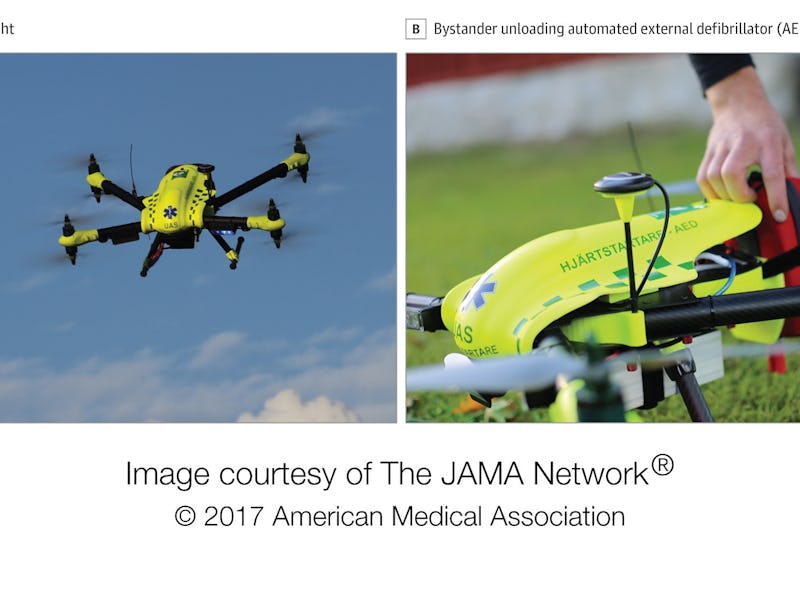Forget Delivering Packages, This Drone Could Stop Heart Attacks
Cardiac arrest victims in rural areas might stand a better chance.

If you’re suffering a cardiac arrest, time is not on your side. As you may remember from science class, your heart needs to keep beating for you to live. Every second your blood’s not pumping is another second your brain is being deprived of oxygen. Doctors know that the best way to restart a person’s stopped heart is with an electric shock from an automatic external defibrillator, and while many public facilities are equipped with lifesaving AEDs, people who aren’t at a hospital — or the mall or movie theater — don’t have quick access to them. Fortunately, it’s Sweden to the rescue.
Scientists have developed a drone that could save the lives of people who suffer sudden cardiac arrest.
Andreas Claesson, a resuscitation researcher at Karolinska Intitutet in Stockholm, and his colleagues published a letter in the Journal of the American Medical Association detailing how they’ve developed a drone that can deliver an AED to a person suffering a cardiac arrest outside the safer environment of a hospital. What’s more, their tests showed that the drone can arrive in less than a quarter of the time it would take an ambulance to arrive.
Claesson tells Inverse that this research was inspired by poor survival rates in certain areas of Stockholm, areas that are heavily inhabited in the summertime but lack sufficient emergency medical services.
This drone could soon deliver an automatic external defibrillator to cardiac arrest patients.
To conduct this research, Claesson and his colleagues stationed a 1.7-pound drone at a fire station outside of Stockholm. They acquired data on all the out-of-hospital cardiac arrests that had occurred within a 6.2-mile radius of the fire station, and used the locations of these events to simulate emergency calls and test the drone’s response time against an ambulance. The drone beat the ambulance every time. While these weren’t actual emergency situations, the researchers’ findings were promising.
“The median time from call to dispatch of EMS was 3 minutes,” write the study’s authors. “The median time from from dispatch to drone launch was 3 seconds.” It doesn’t take much math to see that this is a significant increase, and that’s before the drone and ambulance even make the trip. Once they’re dispatched, the disparity only increases.
From dispatch to arrival, the drone’s median time was five minutes and 21 seconds, while the ambulance’s median time to arrival was 22 minutes. This is a difference of more than 16 minutes, which is huge when you’re dealing with cardiac arrest.
Once this drone delivers an AED, a bystander can use it to assist a victim of cardiac arrest.
“This is a really neat, innovative method to combat a problem that we have been struggling with for decades,” Dr. Michael Kurz, an associate professor of emergency medicine at the University of Alabama-Birmingham, told NPR. “It’s the same reason we have public access to defibrillation. Airports, casinos, large public venues have AEDs on the wall because presumably, it would take a while for EMS to get there. This is, like, public-access defibrillation on steroids, where we just bring the defibrillator to you.”
Claesson is encouraged by this study’s results.
“There is a huge potential with this system as an AED may be delivered within just 5 minutes,” he says. The next steps will be to find out how well bystanders could use the AED once it arrives, but Claesson expects to have bigger trials going soon.
“We believe we may have a fully operational system up running by summer of 2018 or 2019, a clinical study.”
Abstract: Out-of-hospital cardiac arrest (OHCA) affects approximately 55 of 100,000 inhabitants per year in the United States, with low survival (8%-10%). Reducing time to defibrillation is the most important factor for increasing survival in OHCA. Unmanned aerial systems, commonly called drones, can be activated by a dispatcher and sent to an address provided by a 911 caller. The drone may carry an automated external defibrillator (AED) to the location of an OHCA so that a bystander can detach and use it. Theoretical geographical information system models have shown that drones carrying an AED can reduce response times in rural areas. However, whether they reduce response times in a real-life situation is unknown. This study compared the time to delivery of an AED using fully autonomous drones for simulated OHCAs vs emergency medical services (EMS).